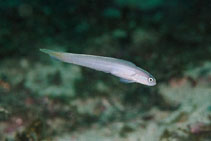| Family: |
Microdesmidae (Wormfishes), subfamily: Ptereleotrinae |
| Max. size: |
8.7 cm SL (male/unsexed); 4.88 cm SL (female) |
| Environment: |
reef-associated; marine; depth range 8 - 70 m |
| Distribution: |
Southwest Atlantic: endemic to Brazil. |
| Diagnosis: |
Dorsal spines (total): 7-7; Dorsal soft rays (total): 22-24; Anal spines: 1-1; Anal soft rays: 21-23. This species is distinguished from its Atlantic congeners by having the following characters: dorsal and anal fins with bright orange-yellow submarginal bands; second dorsal and anal fins comparatively low, slightly elevated anteriorly; short caudal fin, 5ht and 6th rays prolonged as filaments; short pelvic fins, about the same length as pectorals (Ref. 84213). |
| Biology: |
Used in the aquarium trade under the name Opistognathus leitoso. The population is declining fast in some areas of the Brazilian coast (mainly off the States of Espirito Santo and Bahia) due to commercial exploration of the calcareous algae banks. This species hovers over its burrow feeding on plankton and dives headfirst in to the burrow when threatened. Found usually over sandy bottom close to reefs, but also common over sand patches as small as 10 cm in diameter, enclosed by rocky areas or in calcareous algae (Lithothamnion sp.) banks (Ref. 84213). Maximum depth from Ref. 126840. |
| IUCN Red List Status: |
Least Concern (LC); Date assessed: 23 March 2011 Ref. (130435)
|
| Threat to humans: |
harmless |
Source and more info: www.fishbase.org. For personal, classroom, and other internal use only. Not for publication.

